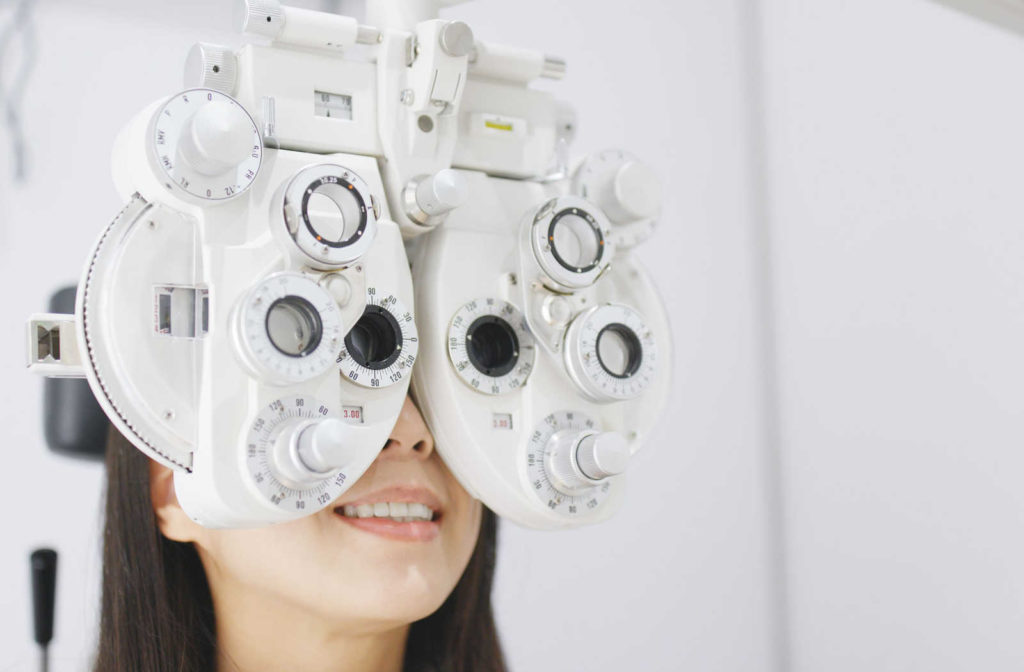Astigmatism and myopia, also known as nearsightedness, have one key similarity: both are refractive errors of the eye. Refractive errors occur when the shape of the eye prevents light from properly focusing on the retina, making it difficult for a person to see clearly.
However, there are some distinct differences between astigmatism and myopia that need to be understood in order to explain which type of vision correction is needed.
Astigmatism and myopia affect vision differently. Astigmatism causes blurry vision at all distances, while myopia causes blurry distance vision.
These conditions tend to develop in childhood, while the eyes are growing. An optometrist can diagnose astigmatism and myopia through a comprehensive eye exam.
What Is Myopia?
Myopia occurs when the eyeball is longer than normal or the cornea has too much curvature. As a result, light rays focus in front of the retina instead of directly on it. This causes distant objects to appear blurry while near objects remain in focus.
Myopia can be corrected with eyeglasses or contact lenses that feature a convex lens power to correct for the refractive error by bending light rays so they can focus correctly on the retina.
Refractive surgery, also known as laser eye surgery, is also an option for most adults with myopia.
What Are the Symptoms of Myopia?
The main symptom of myopia is blurred vision when looking at distant objects.
Other symptoms include:
- Eyestrain and headaches
- Difficulty performing activities that require good distance vision
- Squinting to see objects in the distance better
- Frequently needing a new prescription for glasses or contact lenses
- Holding objects too close to your face to see them better
What Is Astigmatism?
Astigmatism, on the other hand, is caused by an unevenly curved cornea or lens that causes light rays to bend differently at different points. The result can be blurred vision at any distance if left uncorrected because the eyes are unable to properly focus light onto the retina at the back of the eye.
To correct astigmatism, eyeglasses and contact lenses with a toric lens power (sometimes combined with a spherical lens power) are used; these help to evenly refract light rays onto the retina for clear vision at all distances.
Laser surgery, such as LASIK, may also be recommended as a treatment for astigmatism if a person wishes to reduce their reliance on glasses and contacts.
Irregular Astigmatism & Keratoconus
Keratoconus is a disease that progresses over time and affects the cornea. It is also known as irregular astigmatism, and can result in poor vision that cannot always be fully corrected with glasses.
Keratoconus typically starts in the late teenage years, but can also begin in your 20s or early 30s. The disease causes the cornea to become thin and curve outward in an irregular pattern. This distortion of the cornea interferes with vision correction through glasses, making alternative methods necessary to correct vision.
Mild keratoconus can be corrected with glasses, while moderate cases may require rigid gas permeable contact lenses, which allow a liquid reservoir between the lens and the eye that creates a smooth surface for light to enter the eye.
What Are the Symptoms of Astigmatism?
The main symptoms of astigmatism are blurred, shadowed, or overlapping vision at all distances.
Other symptoms may include:
- Eyestrain and headaches after prolonged periods of close-up work
- Difficulty driving or playing sports
- Squinting to see better at varying distances
People with astigmatism may also experience double vision or shadowed vision in one eye due to the irregular curvature of the cornea or lens.

Eye Exams Can Detect Myopia & Astigmatism
Eye exams are important for diagnosing myopia and astigmatism. During an eye exam, a comprehensive health evaluation of the eyes is performed that includes a range of tests to evaluate visual acuity, colour vision, peripheral vision, depth perception, and ocular motility.
With these tests, your optometrist can identify visual impairments caused by nearsightedness or astigmatism. Furthermore, regular eye exams can help monitor changes in vision so corrective lenses or other treatments may be prescribed if needed.
Eye exams are essential for ensuring healthy eyesight and can also detect more serious conditions, such as cataracts or glaucoma, early on before they cause major damage.
Myopia Prevention
Thanks to modern optometry, we can now prevent myopia from worsening. Myopia control is best started at a young age while the eyes are still developing. If your child is diagnosed with myopia, their optometrist may recommend myopia management methods like:
- Specialty prescription glasses—to help relieve eye strain and improve picture clarity on the retina
- Specialty contacts—to help reshape the cornea and stop the development of myopia
- Prescription eye drops—to decrease visual accommodation to delay the elongation of the eye
Although myopia can’t be reversed, we can help control its progression so your child has a better chance of clearer vision as an adult.
Visit Your Eye Doctor for an Eye Exam
Though astigmatism and myopia share similarities in terms of their effects on vision, they have distinct causes and treatments that must be taken into account when seeking out proper corrective measures for each condition.
For more information about astigmatism versus myopia—including prevention strategies—have a discussion with the trusted team at Beyond 20/20 Optometry and schedule your next eye exam with us today.




